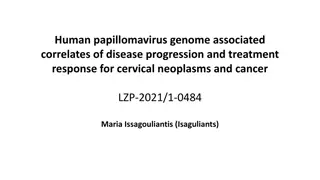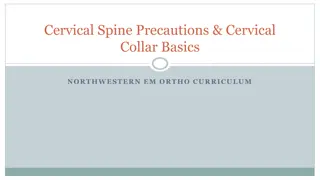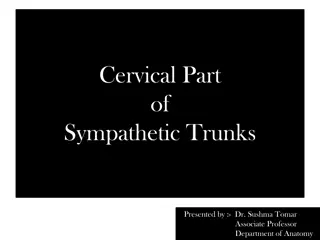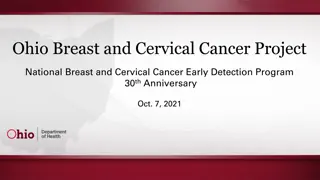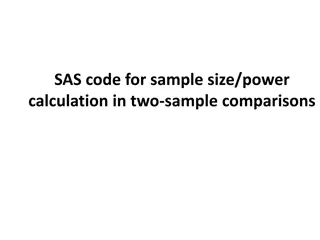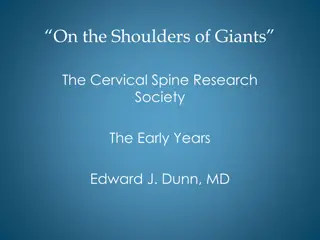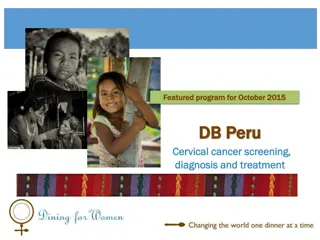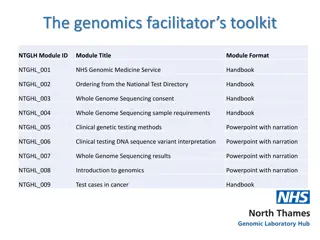Practical Aspects of Taking Cervical Samples: Guidance for Sample Takers
This guidance covers practical aspects of taking cervical samples, including preparing the environment, essential equipment, checking patient identity, and effective communication skills for sample takers to provide information and answer questions. It emphasizes the importance of a warm, well-lit, and private environment, proper equipment like specula and brushes, verifying patient identity with key demographics, and communicating clearly with patients using understandable language.
Download Presentation

Please find below an Image/Link to download the presentation.
The content on the website is provided AS IS for your information and personal use only. It may not be sold, licensed, or shared on other websites without obtaining consent from the author. Download presentation by click this link. If you encounter any issues during the download, it is possible that the publisher has removed the file from their server.
E N D
Presentation Transcript
Guidance for the training of cervical sample takers Topic 8: the practical aspects of taking cervical samples
Note Use these slides in conjunction with the NHS Cervical Screening Programme publication Guidance for the training of cervical sample takers , available at: www.gov.uk/government/publications/cervical-screening-cervical-sample-taker- training 2 Topic 8: the practical aspects of taking cervical samples
Preparing for taking a sample The environment for sample taking should be: warm well lit private comfortable as relaxing as possible 3 Topic 8: the practical aspects of taking cervical samples
Equipment for taking cervical samples Equipment should include: an adjustable height examination couch a good light source specula of different sizes, reusable or once-only use sterilisation facilities if reusable specula are used disposable non-latex gloves information leaflets for people a supply of Cervex-Brush a supply of endocervical brushes a supply of fixative vials packaging for transporting samples to the laboratory / brooms 4 Topic 8: the practical aspects of taking cervical samples
Checking the persons identity At least 3 legible and correct patient demographics are required to identify a person. This enables the laboratory to match with any existing record on the pathology system. The minimum identifying requirements are: the person s full name including first name and surname the person s date of birth ideally the person s NHS number the person s home address, as a fourth identifier 5 Topic 8: the practical aspects of taking cervical samples
Providing information and answering questions (1) Communication is a vital skill for the sample taker and essential for creating a positive experience for the individual. Sample takers should have highly developed personal skills to engage with people and be able to: communicate clear and accurate information offer support and assurance where required undertake health promotion in relation to cervical screening through the use of available resources 6 Topic 8: the practical aspects of taking cervical samples
Providing information and answering questions (2) Sample takers should: use basic language to explain complex medical terminology speak at a measured pace to make sure the person can follow the conversation take the time to ask the person if they have any questions respond clearly and check the person s understanding 7 Topic 8: the practical aspects of taking cervical samples
Providing information and answering questions (3) Sample takers should explain the purpose of cervical screening and what will happen at each step of the procedure. Check that the person attending screening understands: the purpose of cervical screening and its limitations the purpose of testing for human papillomavirus (HPV) the meaning of a normal test result (low risk, not no risk) the meaning of a negative HPV test with abnormal cytology the likelihood of an inadequate test and why this may happen the reasons for being referred following a test (normal or abnormal), which will include the HPV result how and when test results are made available the importance of contacting the sample taker if no result has been received within 2 weeks the importance of always reporting any abnormal bleeding or discharge to their doctor 8 Topic 8: the practical aspects of taking cervical samples
Providing information and answering questions (4) Sample takers should explain to the person what they are going to do during the procedure, and what to expect. A person who is having a test for the first time may need a more detailed explanation, including looking at the speculum and the sampling device. The person needs to know they will have to remove their underwear and that the speculum will be inserted into their vagina. The person demonstrates consent if they are willing to proceed with having screening. The sample taker must document that they gained consent for the procedure. 9 Topic 8: the practical aspects of taking cervical samples
Providing information and answering questions (5) If a person chooses not to proceed with screening, or if distressed by the procedure, then the sample taker must recognise this as their valid choice not to have the test on that occasion. The sample taker may offer another date for the test. Some people may wish to have a chaperone irrespective of the sex of the sample taker. The sample taker should offer the person a chaperone in accordance with local policies. If the person accepts or declines a chaperone, note this on record. 10 Topic 8: the practical aspects of taking cervical samples
Taking and recording a clinical history (1) Ask questions and record responses in line with the sample request form, covering: the date of last menstrual period (LMP) if relevant any abnormal bleeding, such as intermenstrual, menorrhagia, post coital, postmenopausal any unusual vaginal discharge contraceptive use (specify which type) use of hormone replacement therapy (HRT) retroviral infection (RVI) 11 Topic 8: the practical aspects of taking cervical samples
Taking and recording a clinical history (2) Do not take a sample: during menstruation less than 12 weeks postnatally less than 12 weeks after termination of pregnancy (TOP) and miscarriage if there is an abnormal discharge or infection present (treat the infection first; if prescribing a pessary, refer to local clinical guidelines before taking a cervical sample) Avoid cervical screening during pregnancy. We advise people to wait for 3 months after giving birth before taking a sample. 12 Topic 8: the practical aspects of taking cervical samples
Taking and recording a clinical history (3) The screening test is not a diagnostic tool, and a normal test result could offer false reassurance. Refer people with symptoms of abnormal bleeding or persistent discharge, pelvic pain, bloating or urinary symptoms for further investigation without waiting for the test result. 13 Topic 8: the practical aspects of taking cervical samples
Taking a screening history (1) Check the person s screening history, in particular: the date of their last test any abnormal test results Establish that a person is eligible for a test (usually age 24.5 to 64 for routine tests) and that a test is now due (or overdue). Some people outside the standard screening age range may be eligible for screening if: they have a routine recall date allocated as a result of a previous test they are under surveillance or follow-up as a result of a previous abnormality they did not respond to their last invitation and now wish to be tested 14 Topic 8: the practical aspects of taking cervical samples
Taking a screening history (2) If the person has had a previous abnormal result the sample taker should check: when where (the laboratory and the colposcopy unit) the type of result if there was any treatment what (if any) follow-up was undertaken 15 Topic 8: the practical aspects of taking cervical samples
Preparing the request form (1) The sample taker should complete the following data items: surname, previous surnames, first names (check details, including spelling, with the person) a full postal address and postcode (check details, including spelling, with the person) date of birth NHS number name and address of sender if not GP name and address of GP GP code 16 Topic 8: the practical aspects of taking cervical samples
Preparing the request form (2) the person s hospital registration number (if applicable) the source of the sample (type of organisation) the date of the test the first day of last menstrual period whether the person is pregnant, postnatal, has an intra-uterine contraceptive device (IUCD) fitted, or uses hormones the reason for the test any clinical information (completed after sample is taken) sample taker s pin number or code The sample taker must check the details recorded on the cytology request form and electronic record for accuracy. 17 Topic 8: the practical aspects of taking cervical samples
Preparing the equipment for the test Prepare the equipment needed for the test. Check the vial is in date. Fully remove the seal and lid before taking the sample. 18 Topic 8: the practical aspects of taking cervical samples
Preparing and positioning the individual invite the person to step behind the curtain ask them to remove their lower undergarments and lie down on the couch tell them where to place any clothing once they have removed it consider any cultural factors when advising the individual on what clothing to remove advise the individual to remove only enough clothing and undergarments necessary to complete the examination provide a modesty sheet to cover the pelvic area Refer to both the dorsal and the left lateral positions and let the person choose which they prefer. The programme does not advocate an ideal position for taking a sample. 19 Topic 8: the practical aspects of taking cervical samples
Female genital mutilation (FGM) (1) Female genital mutilation (FGM) is mutilation of the labia majora, labia minora or clitoris. The practice is prevalent in many African countries, parts of the Middle East and Asia, and sometimes called cut , circumcision or female circumcision . FGM has been illegal in the UK since 1985. There are 4 recognised types: Type 1: Clitoridectomy part or total removal of the clitoris. Type 2: Excision part or all of the clitoris and labia minora with or without excision of the labia majora. Type 3: Infibulation a narrowing of the vaginal opening with the creation of a covering seal formed by cutting and repositioning the labia minora and/or majora, with or without removal of the clitoris. Type 4: Other includes pricking, incising, scraping, or cauterising the female genital area for non-medical reasons. 20 Topic 8: the practical aspects of taking cervical samples
Female genital mutilation (FGM) (2) Sample takers may have difficulty in passing the speculum in people who have undergone FGM. Complications from FGM may include: difficulty passing urine and a history of recurrent or chronic urinary infections difficulty with menstruation superficial dyspareunia or apareunia recurrent abscesses or cysts particularly in the clitoral area complications in pregnancy and childbirth ongoing psychological trauma from the time of the initial FGM If sample takers encounter medical complications, they should consider referral to a local FGM service to confirm FGM status and possible need for de-infibulation. Alternatively, consider onward referral to specialist gynaecology and or counselling services. 21 Topic 8: the practical aspects of taking cervical samples
Female genital mutilation (FGM) (3) The sample taker must be aware that a person who has undergone FGM may be a vulnerable adult. If the sample taker considers this to be the case, or if there may be a risk to other family members, they should complete a safeguarding risk assessment or discuss the case with their safeguarding officer and share the information with multi-agency partners, for example, health visitors, school nurses or practice nurses, to initiate a safeguarding response. Reporting FGM in people under 18 is mandatory (although out of scope of the screening population) and the requirement to record data on FGM is set out in Department of Health (DH) guidance. www.gov.uk/government/publications/fgm-mandatory-reporting-in-healthcare 22 Topic 8: the practical aspects of taking cervical samples
Choosing the appropriate speculum (1) All sample takers should have a range of specula available including: very small small medium large broad / long The equipment should include a long bladed narrow speculum such as the Winterton speculum, to enable better visualisation of the cervix when the vagina is long or the cervix is lying posteriorly. 23 Topic 8: the practical aspects of taking cervical samples
Choosing the appropriate speculum (2) Check the quality of the equipment selected. When using the speculum, the sample taker should: warm or cool under running water to reach body temperature for a metal speculum (make it clear to the person what is being done) consider using a little water based and carbomer-free lubricant (avoiding the tip of the speculum so as not to contaminate the cervix) gently insert the speculum side-on, directing it downward using gentle, unhurried movements open and close the speculum slightly or change the angle of insertion to bring the cervix into view note that a common error is failure to insert the speculum far enough into the vagina allow time after inserting the speculum to allow the person to relax 24 Topic 8: the practical aspects of taking cervical samples
Appearance of the cervix (1) The sample taker inserts the speculum to: visualise the cervix assess the cervix interpret what is seen 25 Topic 8: the practical aspects of taking cervical samples
Appearance of the cervix (2) The following appearances of the cervix should be familiar: Cervical epithelium The cervical epithelium is of 2 kinds. The multilayered squamous epithelium on the ectocervix appears pale pink, and the thinner columnar epithelium in the endocervix appears red. Cervical eversion This is a wide area of columnar epithelium, also known as ectropion . Opening the speculum exaggerates the appearance further. Cervical eversion does not require treatment unless the person is symptomatic. If symptomatic, refer the individual to colposcopy. 26 Topic 8: the practical aspects of taking cervical samples
Appearance of the cervix (3) Laceration of the cervix This is associated with childbirth, and exposes more of the canal lined by columnar epithelium. Post treatment for CIN You may see a central rosette of reddened epithelium on the cervix, which is asymptomatic and does not bleed to the touch. This represents an old area of healing. 27 Topic 8: the practical aspects of taking cervical samples
Sampling the transformation zone (1) The whole cervix must be visualised to obtain a satisfactory sample. Sample takers should note that: CIN can develop anywhere in the vaginally exposed columnar epithelium, so the whole transformation zone (TZ) needs to be sampled the position of the TZ varies; the part of the TZ adjacent to the squamo columnar junction (SCJ) is the most vulnerable to CIN if the SCJ is visible, the sample must include the whole circumference of the SCJ and the adjacent 1cm of squamous epithelium if the SCJ is in the endocervical canal and not visible, the sample must include cells from the canal in addition to the ectocervix 28 Topic 8: the practical aspects of taking cervical samples
Sampling the transformation zone (2) they must visualise the cervix at the time that the sample is taken, and make sure the whole of the TZ has been sampled (the laboratory cannot be certain that the full circumference of the cervix has been sampled by the cellularity or cell content of the sample; to a cytologist, a sample taken from half of the cervix would look the same as one taken from the whole circumference) if an experienced sample taker is unable to visualise the cervix, the person should be referred to a colposcopy clinic for investigation sample takers should make sure that information about previous treatment (for glandular neoplasia, CIN 2 or CIN 3) is given on the test request form 29 Topic 8: the practical aspects of taking cervical samples
Nabothian follicles These are mucus-retaining cysts formed as islands of columnar epithelium covered by squamous epithelium. They are usually small (about 5mm in diameter), but occasionally may enlarge to 1cm to 1.5cm. The cervix may have a knobbly appearance if several cysts are present. No treatment is required, and a sample can be taken as normal. 30 Topic 8: the practical aspects of taking cervical samples
Polyps The sample taker may take a sample as long as the polyp does not interfere with full 360 degree coverage. If in doubt, refer the person to gynaecology and then sample after treatment (3 months later). Small ectocervical polyps where the base is visible and which are asymptomatic do not require referral for gynaecological opinion. Large, symptomatic or endocervical polyps where the base is not visible should result in referral for a gynaecological opinion (although such polyps are usually benign). 31 Topic 8: the practical aspects of taking cervical samples
People with 2 cervices If a person has 2 cervices, the sample taker must: take a sample from each cervix put each sample into a separate vial label each vial and identify which cervix they have come from (use the person s left and right) 32 Topic 8: the practical aspects of taking cervical samples
Bleeding on taking a sample Bleeding on taking a sample is not uncommon, especially from the columnar epithelium. If the cervix bleeds with no clinical suspicion of malignancy, sample takers should assess the amount of bleeding and consider possible causes. The sample taker should send the sample to the laboratory, and explain to the person that the sample may be inadequate (and they may need to have the test repeated). If bleeding is a repeated problem and causes repeated inadequate samples, or if the person has post-coital bleeding, the sample taker should consider referral to a gynaecologist for further investigation. 33 Topic 8: the practical aspects of taking cervical samples
Clinical suspicion of malignancy (1) Cervical cancer is rare in the UK. Many sample takers will never see a single case. Signs of malignancy include: an enlarged cervix where the surface is irregular and friable, crumbling to the touch (gross example) large blood vessels which bleed freely when rubbed by the end of the speculum an offensive, watery discharge may also be present If the cervix bleeds with clinical suspicion of malignancy, and a clinician considers the cervical appearance is suspicious of malignancy, they must refer the person to a gynaecologist urgently through the cancer wait times (CWT) 2-week wait pathway. Do not take a sample. 34 Topic 8: the practical aspects of taking cervical samples
Clinical suspicion of malignancy (2) Cervical screening is a screening test, not a diagnostic tool. If a person presents to their GP practice with cervical cancer symptoms, the GP should refer them to a gynaecologist. In rare cases, hrHPV may not be present and a normal screening result may occur even though malignancy is present. If the sample taker has any concerns about the person s health when the cervix is visualised, they should seek appropriate clinical advice. 35 Topic 8: the practical aspects of taking cervical samples
Taking the sample Achieve a high cellular yield with correct use of the Cervex-Brush / broom: 1. Insert the central bristles of the Cervex-Brush so that the shorter, outer bristles fully contact the ectocervix. 2. Using pencil pressure, rotate the Cervex-Brush direction. In order to ensure good contact with the ectocervix, bevel the plastic fronds of the Cervex-Brush / broom for clockwise rotation only. / broom into the endocervical canal / broom 5 times in a clockwise The trainee should take care to: make sure the Cervex-Brush apply firm pressure when taking the sample for the entire 5 clockwise rotations move the speculum around if necessary to view the cervix properly / broom fronds are fully splayed 36 Topic 8: the practical aspects of taking cervical samples
Taking an additional endocervical sample (1) An endocervical brush should be used only in a very few circumstances, and always in conjunction with a Cervex-Brush a second sample using an endocervical brush only if: / broom. Consider taking there is difficulty inserting the Cervex-Brush example if the os is narrow or stenosed the person is being followed up for previous borderline changes in endocervical cells the person is being followed up for a previously treated endocervical glandular abnormality (usually when the person has not had a hysterectomy or radiotherapy) when a previous sample was inadequate because of the absence of endocervical cells / broom into the os, for 37 Topic 8: the practical aspects of taking cervical samples
Taking an additional endocervical sample (2) Sample takers should take an endocervical brush sample after the Cervex- Brush / broom sample. 1. Insert the endocervical brush gently into the os, with the lower bristles remaining visible, and rotate clockwise through one whole turn. 2. Fix both samples in the same vial, and clearly note on the cytology request form the use of 2 sampling devices and the reason why. 38 Topic 8: the practical aspects of taking cervical samples
Wide ectropion If a wide ectropion is present, use a Cervex-Brush the sample. / broom to collect If necessary, a use a second brush to sweep the TZ in accordance with the manufacturer s instructions for users (MIU). Fix both samples in the same vial, and note this on the cytology request form. 39 Topic 8: the practical aspects of taking cervical samples
Fixing the sample Use the instructions below to the sample immediately without rushing the technique: 1. 2. Place the Cervex-Brush Push the Cervex-Brush Do this at least 10 times, forcing the bristles apart. Firm pressure is necessary or the cells will cling to the Cervex-Brush / broom. Inspect the Cervex-Brush / broom for any residual material and remove any remaining by passing the Cervex-Brush / broom over the edge of the fixative vial. Make sure the material reaches the liquid to preserve it. Tighten the cap so that the torque line passes the torque line on the vial. Shake the vial if you wiped any material on the edge. Label the vial. If an endocervical sample has been taken in addition, add the brush to the same vial in the same way rinsing it in the vial. / broom as it is into the fixative. / broom into the bottom of the vial using a vigorous swirling motion. 3. 4. 5. 6. 7. 8. You must place the sample in the vial at once to achieve immediate fixation. Do this before removing the speculum. 40 Topic 8: the practical aspects of taking cervical samples
Removing the speculum Withdraw the speculum gently with the blades apart until the cervix is no longer within the blades. Allow the speculum to close and continue to withdraw it until fully removed. 41 Topic 8: the practical aspects of taking cervical samples
Ending the appointment Allow the person time to dress before going on to complete the screening appointment. Check that: you have recorded their name and date of birth on the vial you have completed the cytology request form the detail on the form and vial both match and are correct Explain to the person: how and when they will receive their test result what the results may be what follow-up may be relevant (as appropriate) Check the person understands they should see their GP if there is any abnormal bleeding or discharge, and that they can return to the practice for further advice (consider providing an information leaflet). 42 Topic 8: the practical aspects of taking cervical samples
Completing the request form (1) Complete the clinical data box by: indicating the type of specimen specifying if an additional sample (endocervical) was taken and the sampling device used providing any information on current signs and symptoms detailing any problems with sampling the cervix providing all clinical details, such as unusual bleeding noting any issues regarding the appearance of the cervix 43 Topic 8: the practical aspects of taking cervical samples
Completing the request form (2) Also provide brief details of any significant history, including: abnormal cytology (with slide number) any previous diagnosis and treatment This ensures that the laboratory has sufficient information to make an appropriate recommendation on the person s future management. Check that all the relevant boxes are complete and legible. Sign the form (electronic signature) and provide the sample taker pin code. 44 Topic 8: the practical aspects of taking cervical samples
Documenting the procedure Document the details of the test in the person s records using appropriate codes and templates. These details should include: confirmation that the cervix was fully seen confirmation of sampling from the transformation zone the date the sample was taken the sample taker s details consent obtained other clinical information if applicable Sample takers should record their actions clearly and accurately and use only recognised abbreviations. As a failsafe measure, the trainee should keep a list of all samples sent and correlate this with the results returned by the laboratory. 45 Topic 8: the practical aspects of taking cervical samples
Sending the sample to the cervical screening laboratory Send samples to the laboratory on the same day in order to achieve the programme standard 14-day turnaround for results. Send the sample and the corresponding request form to the cervical screening laboratory, packed in accordance with local arrangements. Make sure the vial lids are fitting correctly to prevent any leakage. Leaking vials could result in the laboratory rejecting the sample. 46 Topic 8: the practical aspects of taking cervical samples
Infection control Sample takers should follow local protocols for infection control. 47 Topic 8: the practical aspects of taking cervical samples
Disposing of equipment and waste Sample takers should dispose of equipment and waste safely in accordance with local protocols. 48 Topic 8: the practical aspects of taking cervical samples
Guidance for the training of cervical sample takers End of Topic 8. the practical aspects of taking cervical samples 49 Topic 8: the practical aspects of taking cervical samples








